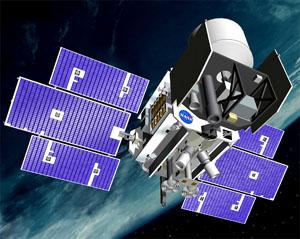 | ICESat
Credit: NASA
|
Class: Earth. Type: Landsat. Nation: USA. ICESat
(Ice, Cloud, and land Elevation Satellite) was the benchmark Earth
Observing System mission for measuring ice sheet mass balance, cloud
and aerosol heights, as well as land topography and vegetation
characteristics. The ICESat mission was
to provide multi-year elevation data needed to determine ice sheet mass
balance as well as cloud property information, especially for
stratospheric clouds common over polar areas. It was also to provide
topography and vegetation data around the globe, in addition to the
polar-specific coverage over the Greenland and Antarctic ice sheets.
ICESat Spacecraft
NASA selected Ball Aerospace to adapt its Ball
Commercial Platform 2000 (BCP 2000) spacecraft bus for the laser
altimetry mission. The entire satellite was assembled at Ball
facilities in Boulder, Colo., and was controlled on-orbit by the
University of Colorado.
Originally designed to accommodate high-resolution
cameras that acquire half-meter class imagery, the spacecraft was well
suited to the ICESat precision pointing control and knowledge
requirements, and also could rapidly orient toward any point within 5
degrees of the ground track.
The spacecraft provided 350 W orbit averaged payload
power. A redundant Solid State Recorder provided 56 Gb of payload data
storage, or 24 hours of science data. The payload data was downlinked
through a 40 Mbps X-band transmitter which allowed 4 hours of data dump
within a typical station pass.
The spacecraft was a fully redundant design that
provided a probability of success of >86% for a 5-year mission life.
The spacecraft bus and payload were powered by two single-axis
articulated solar array wings, consisting of three winglets each. Two
star trackers provided precision pointing and stability. A fixed X-band
antenna was mounted on a post to provide a high bandwidth downlink.
Spacecraft command and telemetry uplink/downlink on S-band frequency
allowed for simultaneous command and telemetry operation. The attitude
control and determination subsystem was designed to allow payload
operation from any orientation, and provided rapid slewing, tracking of
targets, and minimizes vibrations and induced jitter. Two BlackJack GPS
receivers from NASA's Jet Propulsion Laboratory provided precision
orbit determination, timing and geolocation. A hydrazine propulsion
system corrected for any launch insertion errors, and maintained the
correct orbit for ground track repeatability.
ICESat was placed into a 94 degree inclination so each
successive ground track would precess to the West as the Earth rotated,
at an initial altitiude 590 km above the Earth. ICESat's designed
lifetime was for three years of operation with a five-year goal.
The primary instrument was the GLAS (the Geoscience
Laser Altimeter System). GLAS was the first laser-ranging (lidar)
instrument for continuous global observations of Earth, which would
make unique atmospheric observations as an important component of the
ESE climate change program. GLAS was a facility instrument designed to
measure ice-sheet topography and associated temporal changes, cloud and
atmospheric properties.and provided information on the height and
thickness of radiatively important cloud layers which was needed for
accurate short term climate and weather prediction. In addition,
operation of GLAS over land and water provided along-track topography.
GLAS included a laser system to measure distance, a
Global Positioning System (GPS) receiver, and a star-tracker attitude
determination system. The laser transmitted short pulses (4 nano
seconds) of infrared light (1064 nanometers wavelength) and visible
green light (532 nanometers). Photons reflected back to the spacecraft
from the surface of the Earth and from the atmosphere, including the
inside of clouds, were collected in a 1 meter diameter telescope. Laser
pulses at 40 times per second illuminated spots (footprints) 70 meters
in diameter, spaced at 170-meter intervals along the Earth's surface.
ICESat Chronology
13 January 2003 ICESat Launch Site: Vandenberg . Launch Vehicle: Delta 7000. Mass: 1,000 kg. Perigee: 593 km. Apogee: 610 km. Inclination: 94.0 deg. Oceanography,
gravimetry, altimetry mission. Delayed from March 30, May 12, August
30, September 10, December 15 and 20, 2002; and Jan. 11 and 12, 2003.
|